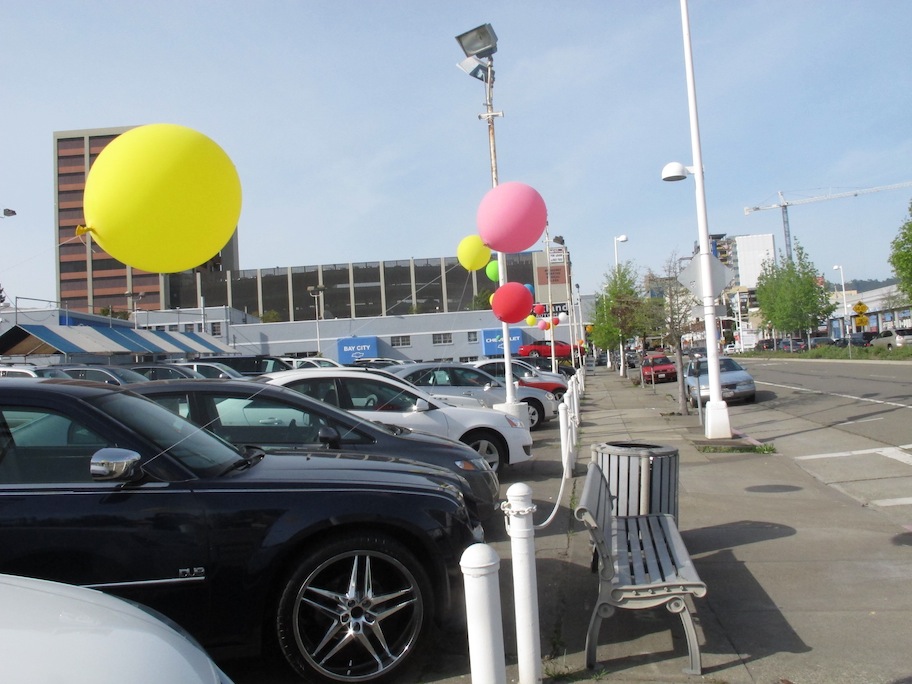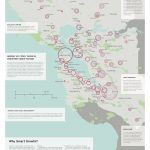Oakland’s Auto Row renaissance may have to work on a smaller scale
Oakland’s Auto Row was once a bustling mecca of retail — a 1.3-mile stretch lined with dozens of dealerships and auto repair businesses that provided the bulk of the city’s sales tax revenue.
But in recent years the strip has fallen victim to a dwindling economy. Car sales dropped 40 percent since 2001, and some dealerships were vacated or abandoned.
Yet the derelict strip has the makings of “smart growth” gold, local urban planners say. It’s near two BART stations and the AC Transit express bus. It’s close to scenic parks, including Lake Merritt. And there are renewed signs of street life, including the monthly Art Murmur gallery crawl and a new Whole Foods.
Since 2000, city officials have had big plans for Auto Row. They called it the Broadway-Valdez project, a 96-acre development that included a strip of housing and restaurants next to the 19th Street BART station, the Valdez Triangle.
Planners said the effort, if fully funded, would be Oakland’s best bet to revive its sagging retail sector. But the project’s prospects have dimmed since California killed redevelopment funds as a way of backfilling the state budget deficit.
Oakland was banking on its ability to lure developers by promoting the project with an estimated $20 million from its Redevelopment Agency. City leaders pitched it as an innovative “private-public partnership.”
That changed in January 2011, when Gov. Jerry Brown announced his intention to dissolve 400 redevelopment agencies across California. Using special tax districts, the agencies provided an estimated $1.7 billion in revenue for cities to combat urban blight. Of that, about $1.36 billion was used to build or promote affordable housing.
This year, without redevelopment, cities will be forced to reinvent their models for both residential and retail expansion.
While redevelopment funds have been used very differently from city to city, planners in economically struggling urban centers doubt that aggressive growth accommodating all income levels can happen without a change in strategy: relying more on help from the private sector to guide and fund infill development.
OAKLAND AS MEGAMALL
The regional smart growth blueprint, Plan Bay Area, leans heavily on Oakland to absorb thousands of new housing units. The plan calls for the city to have 38,950 more housing units in 2040 than it does today, an increase of 23 percent. That is the largest increase demanded of any city in the region. Together Oakland, San Jose and San Francisco must provide one-third of all new housing.
Oakland still is betting that the project will take root with less public funding because of the promise of revenue from a revived retail sector.
Oakland has one of the most under-utilized retail sectors in the United States. About 75 percent of its residents’ purchases, $1 billion annually, are made in neighboring communities such as Emeryville, San Francisco and Walnut Creek. To the city, this represents $10 million yearly in potential new sales tax revenue, as well as 10,400 new jobs.
In 2008, the city released the Oakland Retail Enhancement Strategy, an aggressive plan to turn the Broadway-Valdez corridor into a new retail district.
PowerPoint presentations trumpeted the great megamalls of California as inspiration — photos of Union Square in San Francisco and the Glendale Galleria pop up repeatedly. They dreamed of Nordstrom and Macy’s as desired anchor stores. Early proposals called for more than 1 million square feet of retail space, with significant office construction (up to 150,000 square feet) and entertainment (up to 250,000 square feet).
The plan required funding, both public and private. “Something this significant doesn’t happen totally in the private sector — it will be a public-private project,” said Linda Hausrath, an economic consultant on Oakland’s plan, at a community meeting in 2009.
TOO MANY OWNERS
Though developers would be responsible for the actual building, the city would bundle together a limited number of properties in key locations to lure investors. The Broadway-Valdez district, like many areas settled in the 19th century, is divided into 242 smaller parcels, 75 percent of which are less than a quarter acre. They are in the hands of 135 landowners, a developer’s nightmare.
The area was perfect for redevelopment money earmarked for urban blight. The vast majority of parcels were “underused” — 29 were underdeveloped, 39 used just for surface parking, 15 had vacant buildings, and another 37 percent were deemed “under-utilized” by the city — often large plots of land with small structures. City leaders called consolidation of property ownership “critical for plan success.”
Redevelopment money was also slated to be used to upgrade public works infrastructure such as water and sewer lines in the dilapidated district, where more than half of the structures were built between 1900 and 1920. The upgrades would be necessary to accommodate the needs of modern big-box retail.
But plans to use public funds to push along the private sector ended on Dec. 29, when the California Supreme Court upheld votes by the Legislature to eliminate redevelopment agencies throughout California. They officially dissolved on Feb. 1.
In Oakland, where redevelopment had long been used to fill in funding gaps — including paying staff salaries — the loss of redevelopment created a budget hole of $28 million. In January, Oakland issued layoff notices to 2,500 employees. Any city money for large-scale planning projects, such as Broadway-Valdez, evaporated.
MIDDLE-CLASS HELP
When the economy bottomed out in 2008, private funding for construction and development projects became increasingly limited. Economically stressed cities began turning to redevelopment funding as an increasingly important financial tool to lure developers. Though developers still provided the bulk of financing, redevelopment money could provide incentives such as façade improvement or signage. And cities could purchase and bundle small chunks of land, or underwrite the value of inflated properties.
Redevelopment has also been a tool for creating projects that the private sector will not do on its own, such as multifamily units and homes designated as affordable for low- and middle-class residents. State law requires 20 percent of redevelopment funds be set aside for affordable housing, providing the bulk of affordable stock for many cities.
Some cities exceeded that goal. San Francisco historically allocated 40 to 70 percent of its redevelopment funding to affordable housing projects. For the 2011-12 fiscal year the city set aside $56 million of its $286.1 million redevelopment budget for affordable housing, and another $38 million for public improvements.
But redevelopment’s main goal was to spur the economy to grow, say defenders of the program.
“Almost entirely our activity that we focus on, whether it be economic development, business improvement or acquiring sites, is related to business retention and growth,” said Lila Hussain of the San Francisco Redevelopment Agency, which after official dissolution is now managed by an interim group called an Oversight Board.
NO MONEY, NO PLAN
Without a reliable funding source, Plan Bay Area will move on a slower timeframe, said Ken Kirkey, a planner with the project’s lead agency, the Association of Bay Area Governments.
“We’re in this place where redevelopment is gone, there is nothing to replace it yet, and there has been a huge drop-off, not just in the Bay Area but nationally, in terms of housing permits,” Kirkey said.
So far, the agency has not created a contingency funding plan. “There’s an assumption that something is going to have to come back in that place,” he said.
Reagan-era policies that promoted roads and car-centric housing make it harder to fund transit-oriented infill developments, said Karen Chapple, a professor of urban planning at the University of California, Berkeley, who contributed to the regional plan.
“Without major change at the state and federal level,” she said, the plan “is really a great idea, but it’s just basically impossible to implement.”
It’s also difficult to fund real estate growth in an economy still in the midst of a foreclosure crisis. Chapple anticipates the Bay Area is only halfway through the total stock of foreclosures.
“It means that we’re not going to be building, even though the plan calls for tons and tons of housing in areas that will be sustainable,” Chapple said. “In reality, we’re going to be relying on this foreclosed stock to provide much of our housing in the next decade.”
ROADS, NOT HOMES
The Metropolitan Transportation Commission promises that cities won’t lose basic transit and road maintenance funding. But the grants aren’t designed to build megaprojects or provide any funding for development.
“Where the cities are prioritizing for housing, we can improve the streets, we can improve the road quality by repaving the roads, we can use that money to provide more transit service there — all kinds of things that make it a more desirable place to live — but they’re going to be transportation improvements,” said Dave Vautin, a transportation planner with the agency.
A $14 billion pot for transportation improvements, set to be distributed over 27 years, “sounds like a lot of money, but when you split it up it’s not,” Vautin said. But it is enough to help with things like small streetscape improvements. In the first four years as many as 200 proposed priority development areas will vie for a piece of about $320 million in grant funding — a pittance.
“The amount of money relative to the need is minuscule,” Chapple said.
The grants will be distributed to counties based on a formula: overall population counts for 50 percent, meeting past lower-income housing demands counts for 25 percent and need for future growth counts for 25 percent.
Vautin said the loss of redevelopment money “makes it a bit harder to implement this type of plan. But it really is a visionary plan, and we’ll really need the local jurisdictions to buy into this as well. We as a regional agency can’t really get this done all by ourselves.”
Even if development comes back, it won’t pay for the infrastructure, such as sewers and water systems.
“Can new development help with it? Yes, if it’s replacing the whole system,” said Stephanie Reyes, policy director of Greenbelt Alliance, an affordable housing and open space think tank. “But it’s unlikely new development can help with all of that.”
‘ORGANIC’ GROWTH
With less funding, Oakland has been forced to re-envision development on a smaller scale, crafting a plan for “organic growth.”
The city’s new model for retail: reuse, retrofit, redevelop. The plan called for façade improvements and temporary use of vacant lots — pop-up stores and food trucks. Small, inexpensive pedestrian improvements such as bike lanes and streetlights could bring more foot traffic, and eventually encourage developers to build.
Ed Manese, project manager for the Broadway-Valdez project since 2010, said the new plan relies on community feedback. He worried that a massive influx of retail might create an “inauthentic vision of Oakland.” Instead of large-scale projects, such as parking lots, the new plan would fit about 1,800 more housing units on existing lots.
Though the big projects funded by redevelopment sometimes created a boom in tax revenues, slower growth might be more sustainable. From 1990 to 2001 Emeryville’s redevelopment agency spent $157 million on economic development, working with developers to build a bustling retail sector, which created about 5,500 jobs. But the project had its drawbacks: Because the city meets only 27 percent of its affordable housing needs, many Emeryville workers live in places like Richmond and Oakland.
The East Bay Alliance for a Sustainable Economy charges that fast growth increased income inequality in Emeryville.
“As the North End neighborhood became more affluent, long-term residents were displaced,” the group wrote in a 2003 report. Poverty increased, traffic worsened and all the extra land that might have been used for public purposes was grabbed up by business.
NOT DEAD YET
Marla Wilson, a sustainable communities associate with Greenbelt Alliance who has worked on the Auto Row project since 2008, sees the loss of funding as positive, allowing the city to focus on preserving the character of Oakland.
“There are no specific plans for the site, only conceptual,” Wilson said on a recent walk past the vacant car dealerships on Broadway. “Now there’s a general idea of encouraging business in a smart-growth sort of way.”
Still, Oakland officials maintain that the Broadway-Valdez project is still alive. In February, an East Bay Express cover story proclaimed the project dead, a victim of lost redevelopment funds.
Not so, said the city. “To echo Mark Twain, reports of the death of the Broadway Valdez District Specific Plan have been greatly exaggerated,” Eric Anglestadt, the city’s planning director, wrote in an open letter to the public.
But the plan is not without challenges, including high land values, public safety concerns and a lack of “retail identity” — on top of the Great Recession.
“Doing pedestrian improvements alone will not be enough,” said Wilson of Greenbelt Alliance. “It’s not like you widen the sidewalk and suddenly Macy’s wants to move in. It’s necessary but it’s not sufficient.”
The 1,800 housing units may provide the retail boost the city is looking for. More residents will lure smaller retail jobs without big anchor businesses, Reyes said.
“Given the setup they have, hoping for 1.5 million square feet of retail is likely to be a big failure,” Reyes said. “Why would you want to have a plan that doesn’t go anywhere? Why not build on what works in Oakland: smaller-scale organic restaurants, retail, art boutiques?
“Can Oakland kind of grow its own Oakland-local successful hipster area?” she said. “Maybe they get some American Apparel or hipster retail to go along with the restaurant and arts scene. That could be a way for Oakland to increase its tax base and jobs, while also adding housing.”
“I think one of the biggest challenges cities will have is that the market will build on the easy sites,” Manese said. “For a place as mature and developed as the Bay Area, and for us to densify as much as ABAG and One Bay Area envisions, there are lots of properties that are going to take a lot of effort, which are going to be more than developers can take on alone. They’re going to require a public-private partnership, and unless we have funding to create them we’re not going to be able to reach those goals.”
Read full coverage of Bay Area smart growth in the San Francisco Public Press Summer 2012 print edition, on sale at retail outlets around San Francisco and online.









